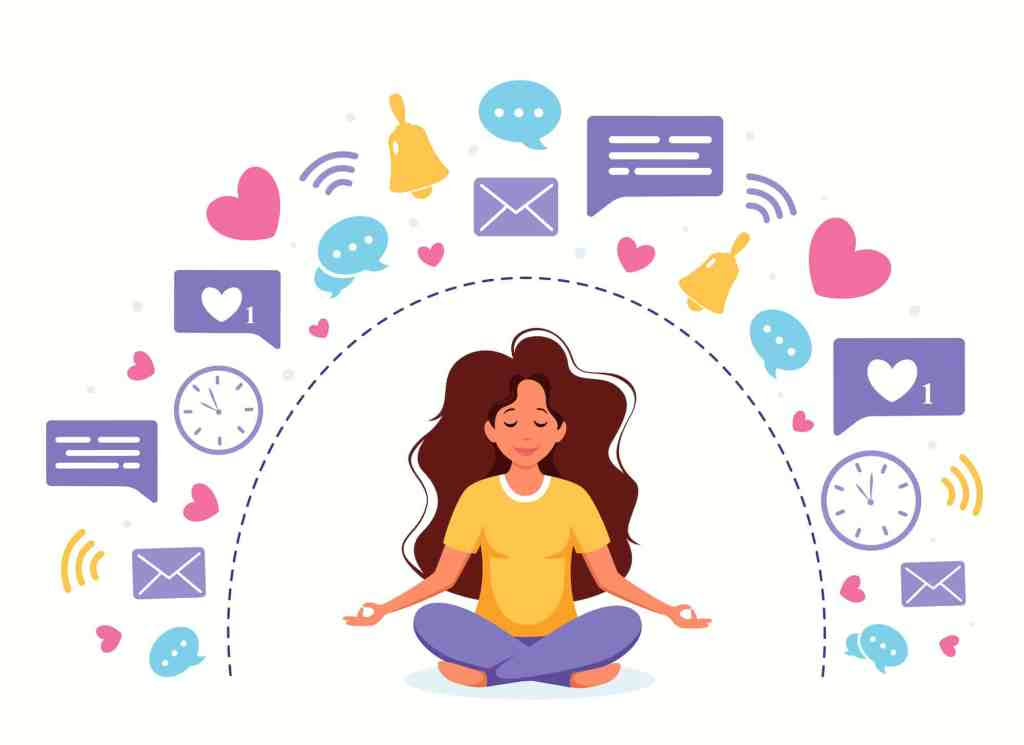In this digital world, our lives revolve around screens. Whether it’s for work, communication, entertainment, or even relaxation, technology is ever-present. While it has brought countless benefits, it has also raised concerns about our mental health, focus, and overall quality of life. This is where digital wellbeing comes into play.
Digital well-being isn’t just about limiting screen time, it’s about creating a harmonious relationship with technology—a balance that promotes health and mindfulness.
And who plays a key role in making this possible? Designers.
Through thoughtful UI/UX design, we can shape digital experiences that promote wellness rather than overwhelm users. This blog explores the role of UI/UX in digital wellbeing and shares tips on designing for balance.

What is Digital Wellbeing?
Digital wellbeing refers to the intentional use of technology in a way that supports mental, physical and emotional health. It’s about creating mindful interactions with devices, apps, and digital platforms. Good digital wellbeing ensures users maintain control over their technology rather than being controlled by it.
Let’s look at some core aspects of digital wellbeing:
- Screen Time Management: Helping users avoid excessive screen time.
- Mindful Usage: Encouraging purposeful and productive use of technology.
- Healthy Engagement: Promoting features that enhance rather than detract from quality of life.
Research shows that overuse of technology can lead to anxiety, poor sleep, and decreased productivity. For example, a 2023 study by Deloitte found that 60% of smartphone users check their devices within five minutes of waking up. Addressing this requires a shift in how we design digital experiences.
Understanding the Role of UI/UX in Digital Wellbeing

A. The Influence of Design on User Behavior
Design has the power to shape user habits. Features like infinite scroll, autoplay, and push notifications are designed to maximize engagement, but they often lead to overuse. These features do achieve business goals but they can harm users’ mental health.
For example, social media platforms are notorious for their ‘sticky’ designs that keep users scrolling. While they’re engaging, they can cause users to lose track of time, affecting productivity and well-being. Ethical design, on the other hand, focuses on creating value for users while respecting their time and mental health.
B. Creating User-Centric Experiences
User-centric design means understanding users’ needs, emotions, and goals. When we empathize with users, we can design interfaces that align with their best interests. For example, adding features like “Do Not Disturb” modes or personalized notification settings allows users to control their digital interactions.
C. Balancing Functionality with Mindfulness
Designing for balance means providing the functionality users need without overwhelming them. For instance, apps like Headspace focus on simplicity, offering mindfulness tools in a clean and distraction-free interface. Such designs prioritize quality interactions over quantity.
Key UI/UX Principles for Designing Digital Wellbeing

A. Simplicity and Minimalism
A cluttered interface can create cognitive overload. Minimalist designs, on the other hand, make navigation easier and more intuitive. Consider the example of meditation apps like Calm, which use soothing visuals and simple layouts to promote relaxation.
B. Customization Options
Giving users control is crucial for digital wellbeing. Features like customizable notifications, dark mode, or screen time limits empower users to tailor their experiences. For example, Instagram’s “Daily Reminder” feature lets users set limits on app usage.
C. Mindful Interactions
Intentional friction can prevent overuse. For instance, when Netflix asks, “Are you still watching?” it subtly encourages users to take a break. Adding pauses or prompts helps users reflect on their usage.
D. Accessibility and Inclusivity
Accessible design isn’t just ethical; it’s essential for digital well-being. Features like larger fonts, voice commands and color contrast settings ensure everyone, including users with disabilities, can interact comfortably.
E. Visual and Emotional Design
Colors, animations, and sounds significantly impact how users feel. Calming color palettes, gentle animations, and soothing sounds can reduce stress and promote positivity. For example, Duolingo’s playful animations make language learning less intimidating.
Examples of Successful UI/UX for Digital Wellbeing
1. Google Digital Wellbeing
Google’s Digital Wellbeing tools are integrated into Android devices, offering features like app timers, focus modes and bedtime reminders. These tools empower users to manage screen time and maintain healthier habits.
2. Apple Screen Time

Apple’s Screen Time provides detailed insights into app usage, allowing users to set limits for specific apps. The “Downtime” feature helps users prioritize offline activities.
3. Headspace
This meditation app’s user-friendly design focuses on simplicity and mindfulness. Its calming visuals and guided sessions make it a standout example of wellness-focused design.
Challenges in Designing for Digital Wellbeing
A. Balancing Engagement and Ethical Design
Businesses often face a trade-off between user engagement and ethical practices. While features that boost engagement can drive revenue, they can also contribute to poor digital habits.
B. User Resistance
Even when wellness features are available, users may ignore them. Designers must find creative ways to encourage adoption without being intrusive.
C. Measuring Success
How do you quantify digital wellbeing? Metrics like reduced screen time or increased user satisfaction can be helpful but may not capture the full impact of wellness-focused design.
The Future of UI/UX in Digital Wellbeing
1. AI Personalization
AI can personalize experiences to suit individual needs, from recommending wellness features to optimizing notification schedules.
2. Mental Health Integration
The integration of mental health tools, like mood trackers or breathing exercises, will become more common in apps and platforms.
3. Ethical Design Guidelines
As awareness grows, more companies will adopt guidelines for ethical design, prioritizing user wellbeing over profit-driven strategies.
To Sum Up
Digital wellbeing is more than a trend—it’s a necessity in our increasingly connected world. UI/UX designers have a unique opportunity to shape healthier digital experiences by prioritizing balance, mindfulness, and user-centricity. By integrating thoughtful design principles, we can create technologies that not only serve users but also care for their wellbeing.
Let’s embrace the challenge of designing for digital balance and make technology a tool that enhances life, rather than detracts from it.
If you’re looking to create wellness-focused digital experiences, Hapy Design is here to help. We specialize in creating thoughtful, user-friendly designs that promote balance and mindfulness. Let’s work together to create impactful designs that truly make a difference.
